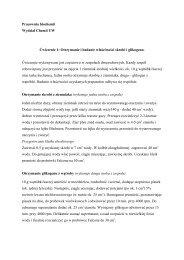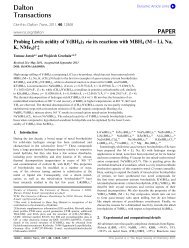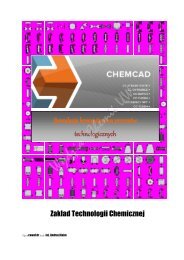Chem. Anal. (Warsaw), 53, 759
Chem. Anal. (Warsaw), 53, 759
Chem. Anal. (Warsaw), 53, 759
You also want an ePaper? Increase the reach of your titles
YUMPU automatically turns print PDFs into web optimized ePapers that Google loves.
778 Z. Hubicki, M. Wawrzkiewicz and A. Wo³owicz<br />
Commercially available anion exchangers containing S, N and O<br />
donor atoms<br />
Many interesting studies with commercial anion exchangers of various types were<br />
performed. Literature data [67, 68] on sorption and separation of noble metal ions<br />
on strongly basic anion exchangers are very important.<br />
Amberlite IRA–900 and Amberlite IRA–410 with functional quaternary ammonium<br />
groups are used for separation of microquantities of Pd(II) ions from Ni(II),<br />
Sr(II), Rh(III), Fe(III), Al(III), Cr(III), Eu(III), Ce(III) and Cs(I) ions in nitric radioactive<br />
liquid wastes. Pd(II) adsorbed in the form of chloride complexes [PdCl 4 ] 2– was<br />
quantitatively washed by reduction with concentrated formic acid. The proposed reaction<br />
mechanism (11–15) is as follows:<br />
finally leading to:<br />
Based on the ion exchange capacities determined by Els et al. [69, 70], the affinity<br />
series for the strongly basic macroporous anion exchanger Amberlite IRA–900 is:<br />
Au(III) > Pt(II) > Pd(II) > Ru(III) > Ir(III) > Rh(III)<br />
Lee and Chung [71] also examined the possibilities of selective removal of Pd(II)<br />
ions from nitric radioactive liquid wastes. They compared sorption characteristics of<br />
Pd(II), Rh(III) and Ru(III) ions onto anion exchangers with functional quaternary<br />
(11)<br />
(12)<br />
(13)<br />
(14)<br />
(15)







